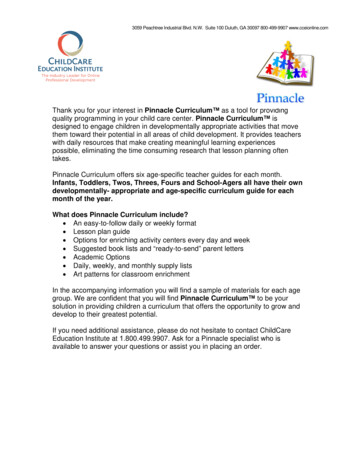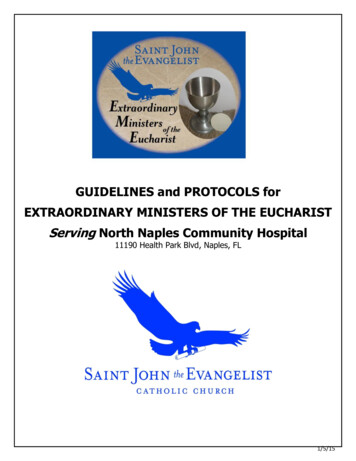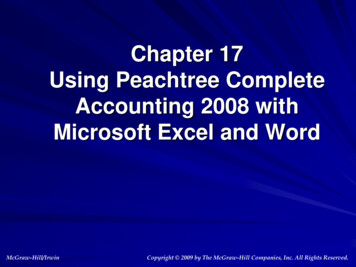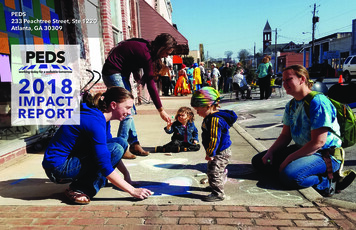
Transcription
3059 Peachtree Industrial Blvd. N.W. Suite 100 Duluth, GA 30097 800-499-9907 www.cceionline.comThank you for your interest in Pinnacle Curriculum as a tool for providingquality programming in your child care center. Pinnacle Curriculum isdesigned to engage children in developmentally appropriate activities that movethem toward their potential in all areas of child development. It provides teacherswith daily resources that make creating meaningful learning experiencespossible, eliminating the time consuming research that lesson planning oftentakes.Pinnacle Curriculum offers six age-specific teacher guides for each month.Infants, Toddlers, Twos, Threes, Fours and School-Agers all have their owndevelopmentally- appropriate and age-specific curriculum guide for eachmonth of the year.What does Pinnacle Curriculum include? An easy-to-follow daily or weekly format Lesson plan guide Options for enriching activity centers every day and week Suggested book lists and “ready-to-send” parent letters Academic Options Daily, weekly, and monthly supply lists Art patterns for classroom enrichmentIn the accompanying information you will find a sample of materials for each agegroup. We are confident that you will find Pinnacle Curriculum to be yoursolution in providing children a curriculum that offers the opportunity to grow anddevelop to their greatest potential.If you need additional assistance, please do not hesitate to contact ChildCareEducation Institute at 1.800.499.9907. Ask for a Pinnacle specialist who isavailable to answer your questions or assist you in placing an order.
SampleToddler Curriculum ChildCare Education Institute3059 Peachtree Industrial Blvd Suite 100Duluth, GA 30097800.499.9907www.cceionline.com
S A M P L E C U R R I C U L U MT O D D L E R S , 1 2 - 2 4 M O N T H S“ W I N T E R W O N D E R S ”Welcome to SamplePinnacle Curriculum “Winter Wonders”The beginning of a new calendar year is upon us! It is a time of fresh starts, promisingfutures, and winter weather. This January, make an effort to hold onto your holiday joythroughout the month that sometimes brings the winter blahs. Create a warm, friendly,and cuddly environment that is a treasure to you and your little ones during the wintermonths. Enjoy one-on-one interaction time with your toddlers as you snuggle and reada book about winter. Introduce them to seasonal clothing, animals, and words thismonth!As you introduce new winter words with a mixture of books and real worldexperiences, find opportunities to repeat them often. Not only will your toddlers’language skills grow as they hear and mimic the words you say, but they will alsoexpand their cognitive skills by associating meanings with the new winter words.Keep the great outdoors in your plans, even as the temperature drops! This will giveyour bundled up toddlers an opportunity to experience the new winter words you haveintroduced them to firsthand. Pediatricians agree that brief trips outdoors are beneficialfor both physical and emotional health. Ask parents to send coats, hats, and mittenseach day, and label them with each child’s name for your sanity’s sake! Be sure toorganize warm outerwear in cubbies to make preparations for going outdoors easier.In a short time, your little ones will know that outside time is coming when they see thecoats and mittens come out of the cubbies!January’s arrival also brings with it the opportunity to make New Year’s resolutions.Take time to look at each of your toddlers, and set a special goal for working with themduring the new year. Will you read a book each day to them? Will you take an extraopportunity to make them feel special with a snuggle? Will you help them learn tobalance as you walk together? Look at their individual needs, and resolve to help yourlittle ones meet them during their time with you in this new year!3 ChildCare Education Institute, 2005 Rev. 11/05
S A M P L E C U R R I C U L U MT O D D L E R S , 1 2 - 2 4 M O N T H S“ W I N T E R W O N D E R S ”1WeekPinnacle: Sample, Week 1Unit Theme: “Snow, Snowflakes, and Ice”IntroductionLet it snow, let it snow, let it snow! This week is full ofopportunities for toddlers to experience the wonders ofwinter! With lots of sensory adventures to choose from, theymay fingerpaint with “snow paint,” explore “melting snow,”and learn all about the color white as you talk about the winterweather and the new year. Learning new skills such as taking turns, sharing, and puttingtheir coats on all by themselves will be the focus of this week. And in all theexcitement, don’t forget to take time for cuddling up and browsing through books andenjoying quiet play with your toddlers. Have fun and share their joy and delight in alltheir new discoveries!Room Enrichment IdeasDecorate the room by hanging snowflake cutouts over the diaperchanging table and adding them to the walls. Create a big snowman todisplay on the wall and dangle paper icicles from the windows. Hangcrystal prisms from the windows too, so they will catch the sunlight coming through.Add a winter window scene to your dramatic play area. Find a large poster of anoutdoor scene and laminate or cover it with clear contact paper. Attach the poster tothe wall about three feet off the floor. Add a window frame and panes with coloredstrips of paper or posterboard. Hang real curtains at the window or make pretendcurtains to add a homey touch. What a fun view for your toddlers!4 ChildCare Education Institute, 2005 Rev. 11/05
S A M P L E C U R R I C U L U MT O D D L E R S , 1 2 - 2 4 M O N T H S“ W I N T E R W O N D E R S ”Radical RoutinesThis week, focus on your one-on-one interactions with yourtoddlers. Send the message that each one is special. Duringthe routines of the day like diapering, arrivals, and departures,make it a point to give each child your full attention. Atmealtimes, sit with the children and encourage conversation.Even though your conversations may seem one-sided, thetoddlers are listening and learning from the things you say.Take time to observe and learn about each child’s individual needs and interests.Toddlers are growing and changing rapidly. Learning language and large motoractivities are of particular interest to toddlers. Tune into the changes they are goingthrough and the new skills they are developing. Support their development bychallenging them to go to the next level. Provide interesting and new experiences butbe careful not to overstimulate or frustrate your toddlers. Observe closely. Reflect onwhat you see and help each child grow to his or her potential!Music, Movement, and FingerplaysEncourage the children to pretend they are snowflakes as you sing thefollowing song to the tune of “Twinkle, Twinkle Little Star:”Snowflakes falling to the ground;Wintertime is all around.It is cold and icy too.Oh, what fun for me and you!Snowflakes falling to the ground;Wintertime is all around.Sing the following song:I’m a little snowman, short and fat.With a carrot nose and a winter hat.When the sun comes out, I’ll melt away.Come build me again on a snowy day!5 ChildCare Education Institute, 2005 Rev. 11/05
S A M P L E C U R R I C U L U MT O D D L E R S , 1 2 - 2 4 M O N T H S“ W I N T E R W O N D E R S ”Language/Cognitive 12 – 18 Months: Make books of winter wonders for the toddlersto peruse. Collect old holiday greeting cards that have pictures ofsnowy scenes. Note: Using cards with shiny colors, textures, andglitter will make these books very attractive to toddlers. Askparents and coworkers to donate old holiday cards they may have. Glue the backsof the cards to a sturdy piece of cardboard so that the card can still be opened.Bind the cardboard pieces together by punching holes along the edges and tyingthem with yarn or by fastening “O” rings. Place the books in your cozy area forthe toddlers to find and look at. Sit with the toddlers and explore the picturestogether. Talk about the pictures. Name the objects, colors, and textures on thecards.y 18 – 24 Months: Cut circles from white felt and place them on the flannelboard touse in building a snowman. Encourage the children to help you count as you buildand invite those who are interested to place the circles on the board with you.Fine Motor 12 – 18 Months: Make white dough by mixing together 3 cupsflour, 2 cups salt, 3 cups vegetable oil, and 4 tablespoons warmwater. Sit with the toddlers at a low table. Give each one a smallamount of the white dough in a cup or plastic bowl to pinch,poke, and pull apart. Talk to the toddlers about what they are doing with the doughand how it feels. Note: This recipe works well because the dough will not dry outif left uncovered. Also, the salty flavor will help to discourage the toddlers fromeating it.y 18 – 24 Months: Make lacing cards so the toddlers can practice using their handsand fingers together. Cut several pictures from magazines, approximately 4” x 6.”Glue the pictures to sturdy cardboard of the same size and cover them with clearcontact paper. Punch holes around the edge of each picture and tie a shoelacethrough one of the holes. Demonstrate for the toddlers how to thread the shoelaceinto one of the holes and pull it through the other side. Encourage them tocontinue on their own, choosing whatever holes they wish to use.6 ChildCare Education Institute, 2005 Rev. 11/05
S A M P L E C U R R I C U L U MT O D D L E R S , 1 2 - 2 4 M O N T H S“ W I N T E R W O N D E R S ”Gross Motory 12 – 18 Months: Gather several beach balls and encourage thechildren to roll, toss, and kick them. Then sit on the floor with alaundry basket on one side of the classroom. Call to individualchildren and encourage them to place their beach balls in thebasket.y 18 – 24 Months: Make “snowballs” for the toddlers to feel and toss. Push a largehandful of fiberfill into the bottom of white tube socks. Tie a knot in each sock toform a ball and secure the filling in place. Fold the loose end of the sock back overthe ball. Place the “snowballs” in a small laundry basket or plastic container for thetoddlers to discover and explore. As the toddlers show interest, initiate a game oftossing the snowballs. Encourage them to toss the balls to you, to each other, andinto the basket.Social/Emotionaly 12 – 18 Months: Learning to share and take turns is difficult fortoddlers. Play a game of taking turns to start the learning processin this area. Bring a stuffed animal with you and sit with twotoddlers. Encourage them to take turns giving the animal a hugand kiss and passing it to the next person. If other children show an interest, invitethem to join in this sharing game. Be sure to praise the children for their effortsand encourage them to “kiss, hug, and pass!”y 18 – 24 Months: Teach the toddlers a neat way to put on their coats. Assist themin laying their coats on the floor in front of them, upside-down with the inside ofthe coat facing up. Instruct them to bend over and put their arms into the sleeves.When their arms are well into their sleeves, have them stand up while they swingtheir arms back and around so that their coats go over their heads and onto theirbacks. The toddlers will feel a great sense of pride in putting their coats on bythemselves.7 ChildCare Education Institute, 2005 Rev. 11/05
S A M P L E C U R R I C U L U MT O D D L E R S , 1 2 - 2 4 M O N T H S“ W I N T E R W O N D E R S ”Pinnacle PointMastering new skills is very exciting for toddlers, and they feel a greatsense of pride in their accomplishments. It’s important to toddlers thatthe special adults in their lives celebrate their successes with them.When toddlers receive praise and acknowledgment such as “Hey, youdid it! You put your coat on all by yourself,” they are encouraged to keep trying newthings. Relishing in the approval of significant adults is also essential for thedevelopment of each child’s positive self-image. Always be on the lookout fortoddlers’ accomplishments – big or small. Make it a point to share in their excitementand support their sense of pride.Sensory Explorationy 12 – 18 Months: Explore the color white. Collect a variety ofwhite objects that have different shapes and textures. Possibleobjects include plastic cups, washcloths, socks, envelopes, yarn,ribbon, strips of paper, fabric scraps, golf balls, fiberfill, etc. Placethe items in a sensory table or low plastic tub for the toddlers to explore. Talk tothem about the objects and emphasize the color white. Caution: Make sure that allthe objects are child-safe.y 18 – 24 Months: Collect foam-packing peanuts – the kind that disintegrates inwater. Place the foam peanuts in a tub or sensory table for the toddlers to explore.Add a small amount of water to the bottom of the tub and encourage the toddlersto mix the peanuts with the water. Talk about how the foam peanuts “melt likesnow.”Art OptionsMake white fingerpaint for toddlers by mixing liquid starch, soapflakes, and baby powder to a smooth consistency. Allow the toddlersto fingerpaint directly on a low table or on a lunch tray or cookie sheet.To save their snowy creations, simply press colored construction paperover their work and carefully lift it off to reveal their designs. Caution: Supervise closely sothat the paint mixture does not end up in the toddlers’ mouths.8 ChildCare Education Institute, 2005 Rev. 11/05
S A M P L E C U R R I C U L U MT O D D L E R S , 1 2 - 2 4 M O N T H S“ W I N T E R W O N D E R S ”Learning Center OptionsManipulatives Center: Provide sponge blocks for the toddlers tomake tall structures and knock them down. Make blocks in a varietyof sizes using thick sheets of foam rubber or use dry soft sponges likethe ones used for washing cars. Place 25-30 sponge blocks in acontainer for the toddlers to find and play with.Dramatic Play Center: Decorate several boxes like sleds so the children can give theirdolls a ride. Include books and magazines in your dramatic play area that containpictures of children and families playing in the snow. Add pictures of skiers and iceskaters to the walls and sides of toy shelves.Outdoor LearningAlthough temperatures are probably chilly, it’s important to take thetoddlers outside, even if it’s only for short periods of time. Be sure tobundle them up with their hands and heads covered. Go for a walk tosee the sights and feel the cold air on your cheeks. Talk about thetemperature of the air and what you see going on around you. Point out differencesbetween what it’s like now and what it is like in the spring.9 ChildCare Education Institute, 2005 Rev. 11/05
S A M P L E C U R R I C U L U MT O D D L E R S , 1 2 - 2 4 M O N T H S“ W I N T E R W O N D E R S ”W E E K L YS U P P L YL I S TGather the Following Items:Snowflake cutoutsBoxesSnowman pictureScissorsBooks and magazines about snowy play Crystal prismsWinter window sceneContact paperColored posterboardCardboardCurtains or pretend curtainsYarn or “O” ringsOld holiday greeting cardsFlourSimple picture books and toys to match SaltCups or small bowlsShoelacesMagazine picture cutoutsVegetable oilWhite pillowcaseBeach ballsLaundry basketsFiberfillPictures of ice skatersLiquid starchVarious child-safe white objectsSoap flakesFoam peanuts that dissolve in waterBaby powderColored construction paperPictures of skiersThick foam rubber or dry soft spongesWhite tube socksStuffed animalsWhite feltLunch trays or cookie sheetsPaper iciclesFlannelboardLarge bowlHole puncherBooks and magazines about families playing in snow10 ChildCare Education Institute, 2005 Rev. 11/05
S A M P L E C U R R I C U L U MT O D D L E R S , 1 2 - 2 4 M O N T H S“ W I N T E R W O N D E R S ”Enrichment Ideas / Individual Instruction11 ChildCare Education Institute, 2005 Rev. 11/05
Weekly Lesson Plan for Toddlers, 12-18 monthsChild's NameSinging aboutMusic and Movement and snowflakes and coldFingerplaysweatherLanguage/CognitiveLooking at books ofwinter wondersChild's NameSinging aboutsnowflakes and coldweatherChild's NameSinging aboutsnowflakes and coldweatherChild's NameSinging aboutsnowflakes and coldweatherChild's NameSinging aboutsnowflakes and coldweatherLooking at books ofwinter wondersLooking at books ofwinter wondersLooking at books ofwinter wondersLooking at books ofwinter wondersplAreaeSample, Week 1Playing with white dough Playing with white dough Playing with white dough Playing with white dough Playing with white doughFine MotorHitting a beach ballHitting a beach ballHitting a beach ballHitting a beach ballHitting a beach ballTaking turns droppingtable tennis balls into ajugTaking turns droppingtable tennis balls into ajugTaking turns droppingtable tennis balls into ajugTaking turns droppingtable tennis balls into ajugTaking turns droppingtable tennis balls into ajugExploring various whiteobjectsExploring various whiteobjectsExploring various whiteobjectsExploring various whiteobjectsExploring various whiteobjectsUsing white fingerpaintUsing white fingerpaintUsing white fingerpaintUsing white fingerpaintUsing white fingerpaintBuilding with spongeblocks and enjoying"snowy" dramatic playBuilding with spongeblocks and enjoying"snowy" dramatic playBuilding with spongeblocks and enjoying"snowy" dramatic playBuilding with spongeblocks and enjoying"snowy" dramatic playGoing for a walkGoing for a walkGoing for a walkGoing for a walkamGross MotorSocial/EmotionalSensory ExplorationArt OptionsBuilding with spongeLearning Center Options blocks and enjoying"snowy" dramatic playGoing for a walkOutdoor Learning*Please write in the child's name at the top of the column and check and date when each child completes each activity.
Weekly Lesson Plan for Toddlers, 18-24 monthsChild's NameSinging aboutMusic and Movement and snowflakes and coldFingerplaysweatherUsing "story boxes"Language/CognitiveUsing lacing cardsFine MotorTossing "snowballs"Gross MotorChild's NameSinging aboutsnowflakes and coldweatherChild's NameSinging aboutsnowflakes and coldweatherChild's NameSinging aboutsnowflakes and coldweatherChild's NameSinging aboutsnowflakes and coldweatherUsing "story boxes"Using "story boxes"Using "story boxes"Using "story boxes"plAreaeSample, Week 1Using lacing cardsUsing lacing cardsUsing lacing cardsUsing lacing cardsTossing "snowballs"Tossing "snowballs"Tossing "snowballs"Tossing "snowballs"amLearning to put on a coat Learning to put on a coat Learning to put on a coat Learning to put on a coat Learning to put on a coatSocial/EmotionalSensory ExplorationExploring foam peanuts Exploring foam peanuts Exploring foam peanuts Exploring foam peanuts Exploring foam peanutsand waterand waterand waterand waterand waterUsing white fingerpaintUsing white fingerpaintUsing white fingerpaintUsing white fingerpaintUsing white fingerpaintBuilding with spongeblocks and enjoying"snowy" dramatic playBuilding with spongeblocks and enjoying"snowy" dramatic playBuilding with spongeblocks and enjoying"snowy" dramatic playBuilding with spongeblocks and enjoying"snowy" dramatic playGoing for a walkGoing for a walkGoing for a walkGoing for a walkArt OptionsBuilding with spongeLearning Center Options blocks and enjoying"snowy" dramatic playGoing for a walkOutdoor Learning*Please write in the child's name at the top of the column and check and date when each child completes each activity.
If you need additional assistance, please do not hesitate to contact ChildCare Education Institute at 1.800.499.9907. Ask for a Pinnacle specialist who is available to answer your questions or assist you in placing an order. 3059 Peachtree Industrial Blvd. N.W. S











